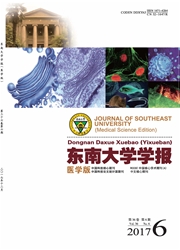

 中文摘要:
中文摘要:
应用层层自组装技术将具有热敏性质的聚N-异丙基丙烯酰胺(PNIPAAm)和具有生物兼容性的海藻酸(ALG)通过氢键引入到微胶囊囊壁中,制备出具生物兼容性、热敏性和pH响应性的微胶囊。在此基础上于微胶囊的最外层额外吸附一层PAH/PSS,使得微胶囊的分散性和稳定性得到极大的改善,同时保持微胶囊的热敏性与pH响应性。利用微胶囊囊壁中丰富的官能团,采用原位还原的方法,将Ag纳米颗粒引入到微胶囊囊壁中,光照后纳米粒子所产生的热量影响微胶囊的渗透性,赋予胶囊光敏性质。此外利用多种表征手段对微胶囊的结构、表面形貌进行了详细的研究,结果表明所制备的微胶囊具有良好的分散性、完整性。此种方法实现了微胶囊对环境的多响应性,将使得微胶囊在药物缓释、生物检测等方面具有广阔的应用前景。
 英文摘要:
英文摘要:
PNIPAAm and ALG were introduced into the shell of microcapsules based on the layer-by-layer technique via hydrogen bond.This render the microcapsules have biocompatibility,thermosensitivity and pH-sensitivity.To improve the dispersity and stability of microcapsules,extra bilayer of PAH/PSS was deposited on the outmost layer of microcapsules.Afterward,Ag nanoparticles were synthesized in the shell of microcapsules by in-situ reduction due to abundant of functional groups.The heat from the nanoparticles after radiated by 420 nm light will affect the permeability of microcapsules,which endows the microcapsules with light-sensitivity.Besides,the structure and surface morphology of microcapsules were assayed by TEM,SEM and AFM,which showed that the microcapsules had a good dispersity and integrality.This method couples multi-sensitivity in one microcapsule,which will extend the application of microcapsules in drug release and sensor.
 同期刊论文项目
同期刊论文项目
 同项目期刊论文
同项目期刊论文
 期刊信息
期刊信息
